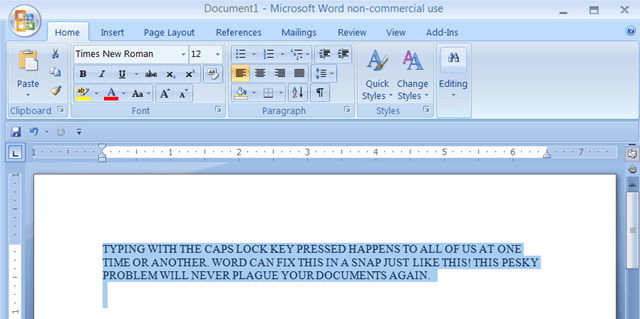

Only capitalize directions when they are part of a proper name.īook Design Tip: Use Small Caps to represent Characters in a Play.īook Design Tip: Use Small Caps for Elegant Headlines.
#HOW TO DO BIG AND SMALL CAPS IN WORD FULL#
Use full caps and leave out the periods for place names, but use the periods for directions. Use full caps and periods for proper names with initials:
#HOW TO DO BIG AND SMALL CAPS IN WORD MANUALS#
Many respected style manuals still attempt to get word processors to emulate a clunky manual typewriter. If you are writing an academic paper, consult your style guide but don’t imagine it to be a recipe for elegant typography. This means that pretty much anything you do, apart from putting periods between the capital letters is technically correct. Unfortunately for the look of the page, other abbreviations traditionally set in small caps should be set in full caps when writing to CMOS specifications.

and p.m.-with lowercase letters and periods. The Chicago Manual of Style offers different guidelines: Instead of am and pm, CMOS specifies a.m. Set “U.S.” in normal caps, but set NATO in small caps. Some publications use small caps for acronyms and initialisms longer than three letters. Book Design Tip: Capitalization and Periods.

The small capitals harmonize better with the surrounding text in the second example. In the first example, the big capitals are jarring they stand out from the text. Acronyms set in big or small caps can omit the periods between the letters with the exception of “U.S.” Use small capitals instead to keep the weight of the type consistent. When regular capitals are used, they create sections of type that are noticeably different than the words surrounding them. Groups of consecutive capital letters often appear in acronyms and abbreviations. Book Design Tip: Use Small Caps Instead of All Caps. Though the characters have the same height as the lowercase letter x (called “x-height” by typographers), they have thicker strokes to match the weight of the big capitals. The “real small caps” example uses small caps designed to harmonize with the big capitals. Notice how the big capitals have thicker strokes than the faux-small caps? Scaling the big capitals down scales down the thickness of their strokes disproportionately. The “fake small caps” example uses scaled down capital letters.

The following examples reveal why small caps are necessary. Choosing a typeface that includes a set of specially designed small caps is also important. In a previous article, I wrote of the importance of selecting typefaces that include both Lining and Oldstyle figures for correct typesetting of numbers. Many thanks to author and typographer Dick Margulis for editing and fact-checking. This article explores proper use of capital letters, explains the difference between big caps and small caps, and offers book design tips to help you manage abbreviations, names, directions, chapter starts and other typographic challenges. A real small cap is different from a full-capital letter in subtle but important ways. Word processors and even some typesetting programs reinforce the abuse of small caps by offering a “small caps” shortcut that scales down the uppercase letters to match the height of the lowercase characters. We all should know that writing in all capital letters is the typographic equivalent of shouting-a “capital” offense.Ī Small Capital (or “small cap”) is a specially designed character- not a regular capital letter scaled down to a smaller size. We all know every sentence begins with a capital letter and ends with a period. Use of Small Capitals-uppercase characters designed at lowercase scale-is one aspect of writing and book design that isn’t taught in grammar school.


 0 kommentar(er)
0 kommentar(er)
